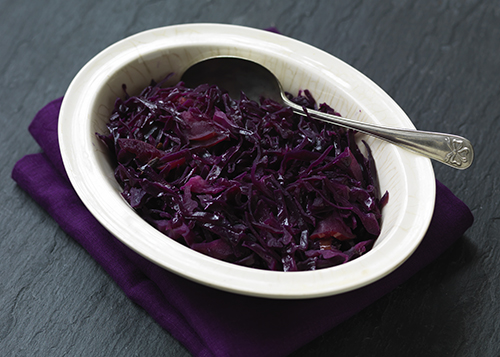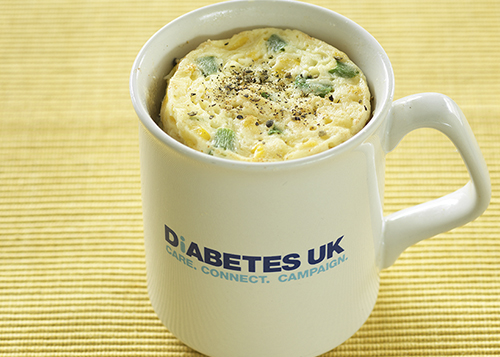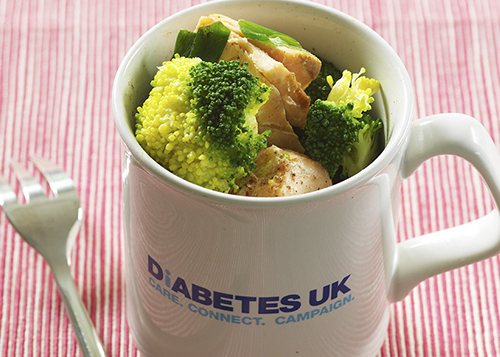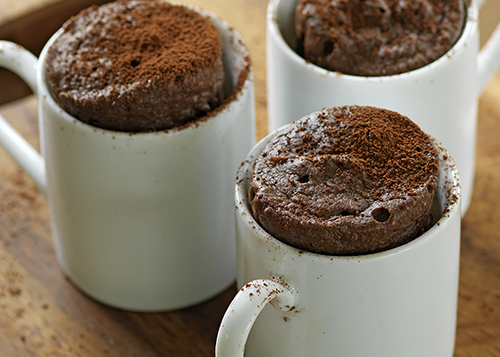Microwave cooking was discovered by accident just after WW2 by a radar engineer who noticed that a chocolate bar in his pocket had melted. Originally called ‘Radaranges’, they first appeared in British kitchens in the mid-1970s.

Are we all just using them to reheat cooked food or drinks or for making a quick jacket potato? Perhaps – but they can do so much more and save you money and time in the process.
If you have diabetes (or not) and fancy a quick, healthy snack in minutes, microwaving a meal in a mug could be the answer. Here we show you how and give you some recipes to try.
8 top tips for perfect microwaving
- Cut foods into even-sized small pieces, they will cook more quickly than large ones.
- Arrange foods so that they cook evenly. Face the thickest parts, like broccoli stalks, outward towards the oven walls. Microwaves cook from the outside in.
- Cover dishes with microwave-safe clingfilm and always pierce the film before cooking.
- Stir, turn, and rotate foods frequently during cooking to ensure heat is distributed evenly. Do this even if your microwave plate rotates during cooking.
- Allow cooked food to rest for a minute or two after the cooking time. This ensures the heat is evenly distributed through the food.
- Pierce foods that have skins, such as sweet potatoes or whole apples, to allow steam to escape.
- Use the defrost power setting to ensure that foods defrost in a slow and even manner. To assist with even defrosting, turn and rotate the food every so often. Be aware that defrosting on full power, rather than the defrost setting, may result in raw, still-frozen areas in the food even though some parts may be piping hot.
- Don't use metal or foil as it reflects microwaves and may cause sparks to fly.
Recipes for you to try:

Red cabbage
This tasty red cabbage can be cooked in the microwave in less than half the time it takes on the hob.
Just add everything to a bowl, cover with clingfilm, pierce and cook for 10 minutes on 800watts. Stir, cover again and cook a further 10 minutes. Leave to stand for 2 minutes and serve.
Sweet potatoes
Sweet potatoes can be easily cooked in the microwave. Just scrub them, wash and prick and cook for 4 minutes turn the potatoes over and give them another 3-4 minutes. Depending on size, repeat until cooked.

Fish parcels
Try these Fish parcels, but remember to use greaseproof paper NOT foil.
Fish steaks can also be cooked in approximately 2-3 minutes in a film-covered dish or try making parcels.

Quick breakfast
Make this Fruity apple and cinnamon porridge or why not try scrambled eggs?Just beat an egg with a tablespoon of semi-skimmed milk and a little pepper. Place in a mug, cover with clingfilm, pierce and cook for 1½ minutes, stirring 2-3 times during cooking. Stand for 1 minute and serve.

A light lunch
Try this cheesy chive and pea muffin or our sweetcorn and cheddar quiche, they’re both delicious served with salad.

Dinner for one
This Sesame salmon and broccoli can be made in under 5 minutes.

Fast puddings
You can easily stew fruit, such as apples and blackberries, or try these deliciously indulgent yet fairly healthy Chocolate banana and almond cups as a special treat.
A healthier way to cook
When you microwave, you don't need to add fat to your food, which is great news if you're managing your weight. When microwaving items such as vegetables in water, as with traditional boiling, nutrients are lost into the water, so it's important not to overcook or use too much water.
Saving money
Microwaves use far less energy than traditional cooking methods, mainly due to the speed at which they cook. Estimates vary, but you could save up to £5 a month by cooking with your microwave.
How do microwave ovens work?
Molecules of water in food are agitated by microwaves which makes them generate heat. Microwaves can pass through plastic, glass and ceramic containers and into the food. Metal containers reflect the microwaves and can cause sparks, so are not suitable. Only use containers that are labelled 'microwave safe'.
Remember, the more in volume you microwave the longer it takes. For example, with conventional cooking, boiling 4 portions of broccoli takes the same time as cooking one portion, but in a microwave 1 portion takes 1-2 minutes while 4 portions require 2-3 minutes, depending on the power of your microwave.
Are they safe?
Microwaves do not always cook evenly and sometimes leave cold spots, which could harbour bacteria, while a hot spot could burn you. This is why it's really important to stir or move food around when cooking or reheating it, to ensure an even distribution of heat. Also, letting food stand or rest for a minute or two after cooking allows heat to distribute evenly through the dish. Again, be sure to give your food a good stir
What can you cook?
Many people only use their microwave for defrosting and reheating leftovers, but you can cook a whole host of things from quick snacks to gourmet treats.
Vegetables
For example, broccoli, purple sprouting, carrots, Brussels sprouts and cauliflower cook well in the microwave. Simply place in a microwave-proof bowl and cover with microwave-safe cling film. Prick the cling film with the point of a knife and microwave on full power (800 watts) for 2-2 ½ minutes then leave to stand for 1 minute. (1000 watt microwaves will take slightly less cooking time so check your handbook.)
